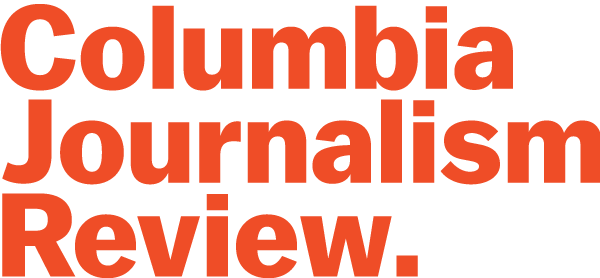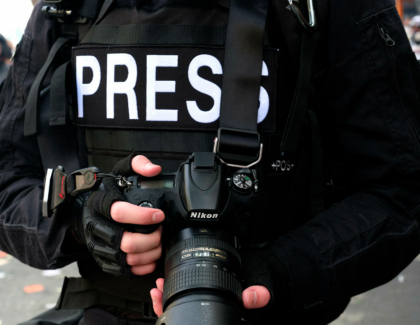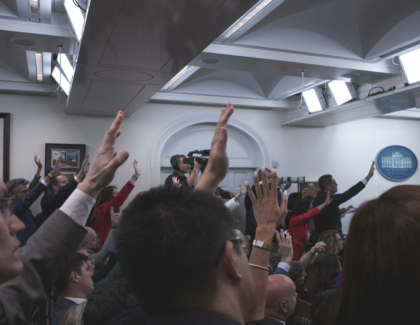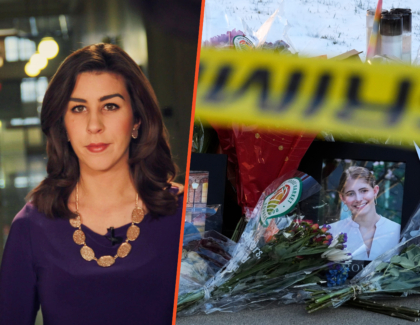Sign up for the daily CJR newsletter.
It might seem like conventional wisdom among journalists that while the world around us may change, our standards do not. And certainly our ethics should not change.
We believe in accuracy. In being honest with the public. In declining favors or gifts intended to bring more favorable coverage. In protecting our sources. When I entered journalism, in the 1980s, these values were a given; when I became the public editor of the New York Times, in 2012, they were still what good journalists held tight. And now that I teach a journalism ethics class at Columbia Journalism School, these are some of the principles I try to pass along to students.
Yet a fresh look at journalism’s standards and practices—yes, its ethics—seemed a worthwhile pursuit in this moment. Trust in the press has declined. Politicians and other public officials, led by Donald Trump, lie to the media and to the public, and we have to decide how best to cover those lies. Internally, journalists are debating the merits of old-style objectivity in the approach to news. And the rapid growth of AI presents new quandaries—and sometimes real disasters, such as when several publications recently published a summer reading list with books that don’t exist. How much should journalists tell the public about our use of AI, and how much should we be allowing its enormous power to accomplish what used to be our work?
So that is what we will be doing in a series of pieces this summer at CJR: taking a fresh look at how traditional journalistic values apply in the current moment. This effort is the result of months of interviews with scholars and journalists, including many standards editors in the biggest newsrooms in the US. Much of the digging was done by Julie Gerstein, a veteran editor and a research fellow with me at Columbia’s Craig Newmark Center for Journalism Ethics and Security.
You’ll read not only their thoughts and our analysis but reactions to these subjects from other knowledgeable and thoughtful people. We’d love to hear from you, too, as we roll these pieces out over the next few months.
We begin with a question that took center stage the moment Trump took office during his first term. You’ll recall that he claimed that his inaugural crowd was the largest in presidential history, and how he sent his press secretary—Sean Spicer, at the time—out to insist that it was true, all evidence to the contrary notwithstanding. Soon afterward, Kellyanne Conway, a top Trump aide, offered the notion to NBC’s Chuck Todd that there was such a thing, after all, as “alternative facts.”
Four years later, a much more serious subject took center stage: the Big Lie, as some called it, that Joe Biden had not legitimately won election in 2020. Again, there was no evidence for this “alternative fact.” But the press had to decide how to cover something that elected officials were constantly repeating, in public and on the air.
And not only how to cover it, but how to refer to it. Were we dealing with “misstatements”? “Baseless claims”? Statements that were contrary to the evidence? Could we and should we use the word lie? What seemed obvious to some news organizations ran contrary to the long-held practices of others.
Now, several months into a second Trump term, the alternative facts are flying fast and furious, in press briefing rooms where attendance has been limited to media organizations that will ask softball questions and provide sycophantic coverage. The circumstances are pressing all of us to reconsider how we tell fact from fiction—and truth from lies.
Other notable stories:
- Today, the House of Representatives is expected to vote on a so-called rescissions package that, among other things, would claw back funding that Congress already approved for the Corporation for Public Broadcasting, which passes through federal cash to NPR, PBS, and public media stations around the country. While Republicans have tried to cut funding for public broadcasting before, this effort has been perceived as a particularly sharp threat, with President Trump leading the charge, and Republican lawmakers who previously stood up for their local stations, especially in rural areas, appearing less solid in their support this time. It still isn’t clear that the package has the votes, however. Lisa Desjardins, of PBS, reported yesterday that four House Republicans have concerns, which would be enough to kill the measure.
- For CJR, Liam Scott reports on a trend of small-town newspapers folding across America—not because of financial ill-health, but due to their publishers retiring, getting sick, or dying without a succession plan in place. The problem is growing “in nearly a dozen states, according to a tally by CJR and a number of statewide press associations,” Scott writes. “When these papers close, publishers and press association leaders say, they hardly ever reopen. Without a common touchstone that informs people about what their neighbors are doing, a town’s sense of identity and history is often at stake.” In response, press groups are working with publishers on succession planning and appealing to community members to pick up the slack.
- Semafor’s Prashant Rao reports that a growing number of US-based nonprofits, including some focused on press freedom, are considering setting up legal entities in a range of European countries as “a precautionary measure” amid concerns that the Trump administration is planning to target such groups, including by changing their tax status. Per Rao, the Committee to Protect Journalists has directed a British law firm to establish an entity in the UK; CPJ told Rao that the plans aren’t finalized, and have partly been driven by a longer-term desire to expand its fundraising efforts, but that the new administration’s actions have “certainly focused our minds.”
- In media-jobs news, the journalism school at the University of California, Berkeley, named Michael Bolden, the current head of the American Press Institute, as its next dean. Elsewhere, Chicago Public Media appointed Aron Pilhofer to oversee its product and membership strategy. And for the first time, the New York Times will have two chief restaurant critics, Ligaya Mishan and Tejal Rao—part of “an effort to expand starred restaurant reviews across the country.” The pair will also forgo their traditional anonymity, with the paper “more or less 86’ing” wigs and fake glasses.
- And in the UK, the star former soccer player David Beckham, of “Posh and Becks” and LA Galaxy fame, will guest-edit an issue of Country Life, a magazine that celebrates “modern rural life and all its diverse joys and pleasures.” “As soon as we were introduced, David told me how much he loves Country Life,” Mark Hedges, the editor in chief, said. “He reads every issue from cover to cover and it’s been a great companion to him as he’s developed his own life in the countryside.”
Has America ever needed a media defender more than now? Help us by joining CJR today.







